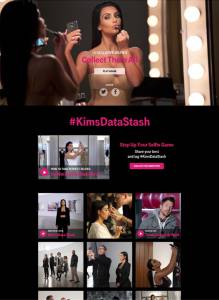Telecom ads were sprinkled throughout this weekends Super Bowl XLIX, most of them taking a comedic angle. From my perspective, however, the two wireless “underdogs” Sprint and T-Mobile made the most significant waves, which started on the TV screen, rippled onto social media, and were sustained by the fiercely competitive spirit of the industry.

The commercial (which was revealed several days before the big game), showed Kardashian lamenting that those without T-Mobile’s rollover data offering, “Data Stash,” would lose their unused data at the end of the month—data that could be used to view the many selfies she posts online. During the ad, viewers were invited to visit kimsdatastash.com, where they could connect their Twitter account to see a “personalized” video message from Kim. Once connected, the viewer saw a dynamically generated video showing their personal Twitter handle in an image of Kim’s phone, and then “Kim” sent one of ten auto-generated messages to the viewer on Twitter. Whether or not you’re a Kim Kardashian-West fan, T-Mobile’s ad was clever. Mintel research shows that advertising featuring popular athletes or celebrities were cited among the favorite sports-related ads (36%). Utilizing Kardashian’s “love to love” or “love to hate” persona, T-Mobile succeeded in driving consumers to both the landing page and Twitter to amplify its messages. Campaigns like this explain how T-Mobile gets so much extra mileage from a marketing budget it says is three times smaller than what AT&T and Verizon are spending.
29% of millennials habitually use electronic devices while watching live sports events
The impact of Sprint’s Super Bowl commercial on social media played out a little differently. The commercial—which pokes fun at Verizon and AT&T by first apologizing for comparing them to a screaming goat, but then likening them to an ass (or donkey)—incited a Twitter battle almost immediately following its airing. Verizon responded, as did the outspoken T-Mobile CEO Legere (even though the TV spot didn’t mention T-Mobile). Sprint’s CEO Marcelo Claure retweeted tweets knocking T-Mobile’s Kim K. commercial, and those praising the Sprint commercial. The TV commercial marks a much more aggressive image Sprint has been building since Claure took over the helm in 2014, and in my opinion will resonate with consumers, especially men. As found in Mintel’s Marketing to Millenials US 2014 report, 22% of US men who saw an ad on TV visited a company website and 32% of US men talked to friends or family about an ad they saw on TV. The brand has come a long way from their “Framily Plan” campaign, and this year’s Super Bowl ad, as much criticism as it may have received, succeeded in getting the competition riled up—and people talking.
It’s also worth noting that T-Mobile ran a second on-air commercial featuring its WiFi calling, which was written by its comedic stars Chelsea Handler and Sarah Silverman. According to T-Mobile’s CMO Mike Sievert, “we’re a brand that is resonating with people who are young and young at heart, people embracing the digital age.” This mentality, which is woven throughout T-Mobile’s brand strategy, is meant to be reflected in the celebrities starring in its Super Bowl spots. According to Mintel data, millennials are on the same page. 29% of millennials think brands that don’t communicate with customers via technology are outdated. Additionally, 28% of millennials think all brands should have a presence on social media.
The 2015 Super Bowl Ad Wars were fierce and, in many options, the best yet. But T-Mobile played to their strengths leveraging social media, celebrity caché and millennial engagement, elevating them to victor status.








































